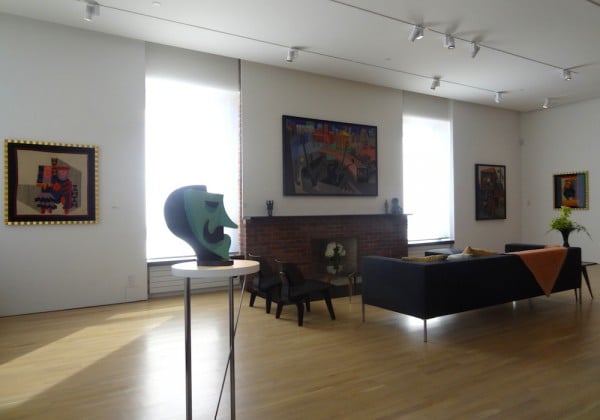
Manhattan’s Center for Italian Modern Art (CIMA) offers attractions for serious scholars and novices alike. The new non-profit art foundation, which opened its beautiful and airy SoHo loft space to the public on February 22, is first and foremost a place where serious scholarship is conducted, with fellowships awarded to art historians doing work on Italian modern art.
CIMA is also an exhibition space, with long-term presentations on specific artists or groups of artists dictating the fellows’ focus and informing their research; the current subject of study is the work of polymath Futurist artist Fortunato Depero (1892–1960). The Depero show launched with a day of lectures, discussions, and tours, and will be accompanied by a catalogue.
And, crucially, it is a sanctuary where the public can experience artworks on exhibit for the first time in New York. The lion’s share of the artworks comes from the collection of Gianni Mattioli, whose daughter Laura Mattioli founded the center in 2013.
“My father had an apartment full of all the paintings of the collection close to his house,” Mattioli recalled during a recent tour of CIMA’s sunny loft. “The apartment was only for the artworks. He opened it for free to the public and then went himself to explain to the people what modern art was; he did this for 15 years. And I think CIMA came from this experience.”
Installation view of “Fortunato Depero” at the Center for Italian Modern Art.
Photo: Benjamin Sutton.
The current presentation devoted to Depero carries on in this open, domestic format. The artist’s dramatic, Giorgio de Chirico–evoking Citta Meccanizzata Dale Ombre (City Mechanized by Shadows) from 1920 hangs over the mantelpiece, guarded by the artist’s tiny wooden sculpture of a robot with a big gray heart (Selvaggetto, 1919). The apartment’s pristine kitchen features two copies of Depero’s 1927 tome Libro Imbullonato (Bolted Book), one still bolted together, the other unscrewed and spread over the room’s walls. In the hallway, greeting visitors as they emerge from the elevator, is Diavoletti di Caucciu a Scatto (Little Rubber Devils) from 1919, a strange and vivid painting of an outrageously colorful dance or parade that seems to draw upon influences from Futurism and Surrealism, as well as from decorative and folk art forms. Over the couch in the master bedroom one of the presentation’s many textile works, Nove Teste con Cappello (Nine Heads with Hat) from 1929–30, gives a sense of how Depero’s style changed during this three-year stint in New York, and startlingly anticipates the serialized and simplified imagery of Pop art.
“We want to show something that’s never been shown in New York,” Mattioli said. “This is a policy we have with the foundation, to show something that we think is very good but we don’t have the possibility to see here.”
Installation view of “Fortunato Depero” at the Center for Italian Modern Art.
Photo: Benjamin Sutton.
The Depero presentation certainly fulfills that mandate, spanning his colorful, large-scale canvases, similarly dazzling tapestries, more strictly Futurist drawings and paintings with more muted palettes and mechanized forms, his magazine and advertising work, stage designs, wooden sculptures, and more. It offers an exceptional opportunity to become better acquainted with one of the artists featured in “Italian Futurism, 1909–1944: Reconstructing the Universe,” the Guggenheim Museum’s new exhibition chronicling the history of the Futurist movement. The museum’s show features a focused selection of Deperos, including 11 on loan from the Mattioli collection; CIMA is showcasing the full breadth of Depero’s production with more than 50 pieces.
CIMA’s next presentation will focus on Medardo Rosso (1858–1928), with a selection of his sculptures, drawings, and between 40 and 50 of his little-known conceptual photographs.
“At CIMA, the goal is to raise awareness of Italian art and every year they have a presentation on an Italian artist or group of artists,” said Vivien Greene, the Guggenheim’s curator of 19th and early-20th century art, who curated the show at the Guggenheim and is on CIMA’s advisory board. “So it has a specifically more study-based role, the fellowships the foundation awards are its primary raison d’être. The way that it will raise awareness of Italian art is through education and allowing people to pursue research on Italian modern art.”
Installation view of “Fortunato Depero” at the Center for Italian Modern Art.
Photo: Benjamin Sutton.
“The place is meant to be like a lab where people have this chance to have serious exposure to art over a period of time,” says CIMA executive director Heather Ewing. “This year we just had the two fellows for the whole year; next year we’re hoping to do more semester-long fellowships in order to give more students the opportunity. And we also are introducing a fellowship for somebody to go to Italy, so next year it will be more expansive.”
“Fortunato Depero” continues at the Center for Italian Modern Art through June 28, 2014. Guided tours led by fellows must be booked ahead of time.
Installation view of “Fortunato Depero” at the Center for Italian Modern Art.
Photo: Benjamin Sutton.
Installation view of “Fortunato Depero” at the Center for Italian Modern Art.
Photo: Benjamin Sutton.
Fortunato Depero, Spazialità lunari – Convegno in uno smeraldo (Lunar Space-Conference in an Emerald) (1924).
Photo: Benjamin Sutton.
Fortunato Depero, Motociclista, solido in velocità (Biker, Solid at Speed) (1923).
Photo: Benjamin Sutton.
Fortunato Depero, Diavoletti di caucciù a scatto (Little Rubber Devils), 1919.
Photo: Benjamin Sutton.
Fortunato Depero, Flora e fauna magica (Magical Flora and Fauna), 1920.
Photo: Benjamin Sutton.
Fortunato Depero, Cavalcata fantastica (Fantastical Ride), 1920.
Photo: Benjamin Sutton.
Fortunato Depero, Due maschere tropicali (Two Tropical Masks), 1920.
Photo: Benjamin Sutton.
Fortunato Depero, Cavaliere piumato (Plumed Knight), 1923.
Photo: Benjamin Sutton.
Fortunato Depero, Bambina e marinaio (Young Girl and Sailor), 1917.
Photo: Benjamin Sutton.
Fortunato Depero, Testa (Head), 1923.
Photo: Benjamin Sutton.
Fortunato Depero, Io e mia moglie (I and My Wife), (1919).
Photo: Benjamin Sutton.